Author: Neluni Tillekeratne, Sri Lanka Project Officer
It has now been 9 years since Sri Lanka's three-decade-long civil conflict came to an end. In the period following the end of violence, Sri Lanka saw a surge in economic growth, due in part to increased investment in infrastructure. However, this surge was not sustained, and the economy's growth rate has slid back to moderate levels. As described in a recent lecture by Professor Ricardo Hausmann, Sri Lanka's growth is ultimately limited by a few factors, especially due to insufficient export diversification and lack of FDI.
Given the need for a new approach to attracting FDI’s and maximizing the potential of export earnings, the Sri Lankan government has been exploring new strategies to make informed decisions on how best the goals of investment attraction, promotion and export diversification, could be achieved.
The Board of Investment (BOI) and the Export Development Board (EDB) are two key government institutions in this regard. These two institutions, with support from the Center for International Development at Harvard University (CID), tried and tested "Sector Targeting" as a new approach to addressing the above-mentioned challenges. The initial research report was compiled with support from CID's Building State Capability program.
The approach has been tried, tested and proven effective, based on findings over a period of two years. The following post will look at the Sector Targeting Program and its impact.
Part 1: Why BOI and EDB opted for sector targeting
What is "Sector Targeting" and why target?
Sector targeting is the act of governments pro-actively studying market opportunities, determining a short list of sectors which could be accommodated through existing public infrastructure and approaching potential investors. The "targeting exercise" allows government officials to be well-informed of a sector and approach interested investors by making an initial correspondence. This method of attracting FDI is in contrast to the more traditional approach of responding to interested investors who initiate correspondence with the government.
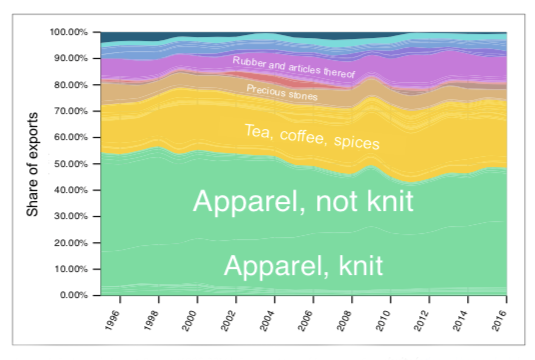
Figure 1: Sri Lanka's export basket (1996-2016). Source: Atlas of Economic Complexity.
Despite being a pioneer in adopting open economic policies as early as 1978, Sri Lanka’s foreign direct investment (FDI) inflows have been insignificant over the last 3 decades. Unsatisfactory performance in attracting export-oriented FDI has a direct bearing on a country's export performance, resulting in a small basket of primary exports for over two decades, which is stagnating or in a declining phase. In fact, it can be noted that more than 60% of the total merchandise exports of Sri Lanka has been generated by three major product categories, namely Apparel and Textiles, Tea, and Rubber. (Excerpt from the report: Targeting Sectors for Investment and Export Promotion in Sri Lanka)
The current strategy for investment promotion in Sri Lanka is to focus on improving incentives for investors. Despite decades of attempts at perfecting this approach, Sri Lanka was not attracting a competitive number of FDI's compared to peer countries in the region. Recent reviews of these incentives revealed that a fundamental issue is the lack of a valid scientific basis upon which sectors were identified to be promoted to investors, with ad-hoc criteria being used. The approach was not "targeted" in terms of identifying competitive sectors through evidence-based research. Sri Lanka does not match up to the FDI's attracted by countries who used a targeted approach in promoting investments. Considering the downward trend of FDI attraction, the BOI used the opportunity of collaborating with Harvard University to deduce a sector targeting strategy for GOSL.
Report on “Targeting sectors for Investment and Export Promotion in Sri Lanka” by the “Sector Targeting Team”
The report was compiled as a joint effort by 20 officials from the BOI and EDB who formed a “Sector Targeting Team” (T-Team). The team assessed 30 sectors – all tradable activities (goods and services) of the private sector – and finally ranked their top sectors for export promotion and strategies for promoting them.
The conceptual framework followed to compile the research was an iterative process as seen in the diagram below (Figure 2). The team began by determining targeting criteria of sectors. Once the criteria were determined, data collection and analysis along multiple tiers led to two outcomes a) determining sectors that should be a priority when approaching investors and b) promotional strategies for these sectors.
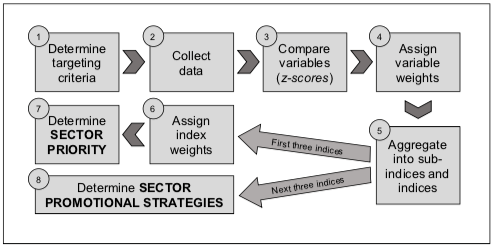
Figure 2: Conceptual framework of study (source: Targeting Sectors for Investment and Export Promotion in Sri Lanka)
Taking a closer look at the study methodology
The Targeting Team first developed three key indices to determine the top sectors which should be prioritized for more in-depth analysis. The indices were
- Market opportunity
- Investor interest
- Impact to the economy
An overview of the indices and sub-indices used in this initial assessment is seen in the diagram below (Figure 3).
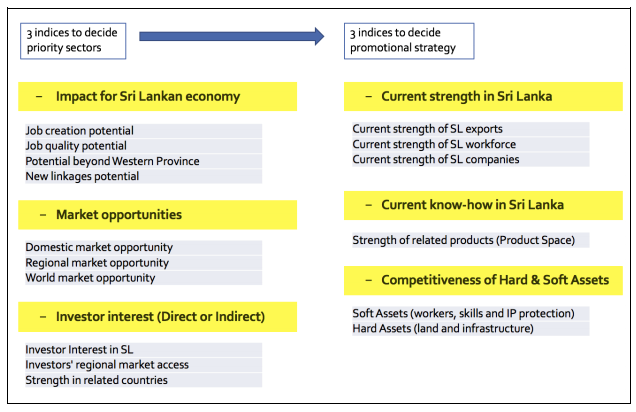
Figure 3: Template used for evaluating sectors (source: Targeting Sectors for Investment and Export Promotion in Sri Lanka)
Each of these key indices was composed of multiple subindices (Figure 3), which in turn were composed of quantitative variables from various datasets. The following image (Figure 4) is an example of variables used to assess one such indicator, the Impact for Sri Lankan Economy index. This index measures job creation, job quality potential, potential beyond western province and new linkages potential. Each such sub-indices looked at multiple variables eg: Job quality potential was measured using five variables; average wage (comparing Sri Lanka, Peer Countries and USA), Youth Employment and Female Employment.
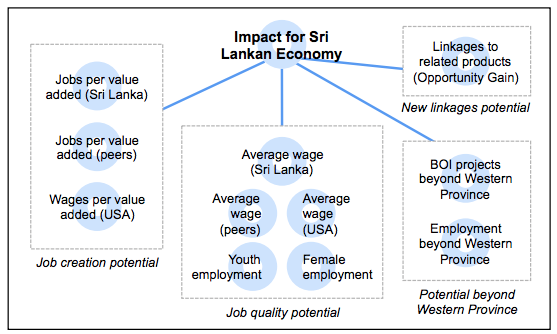
Figure 4: Variables used to build the "Impact for Sri Lankan Economy" index (source: Targeting Sectors for Investment and Export Promotion in Sri Lanka)
The analysis led to identifying 6 high-potential sectors with 16 subsectors. Once these top sectors were identified, the sectors were further assessed to identify an appropriate promotional strategy for each, by considering:
- current strengths of Sri Lanka,
- sectors’ feasibility (based on the country's current knowhow),
- availability of needed hard and soft assets.
Results: Sector rankings and promotional strategies
The top sectors, with their respective promotion strategies, are shown in Figure 5. Based on their capacity to offer benefits to the economy, six sectors (and 16 subsectors) were identified as priority sectors for promotion: electronics, industrial machinery, automotive, tourism (not shown), electrical equipment, and fabricated metal products. For each of these, promotional strategies were deduced as follows:
1. Attracting FDI: priority sectors that could benefit from new knowhow from abroad;
2. Promoting exports: priority sectors with established and emerging exporters to support.
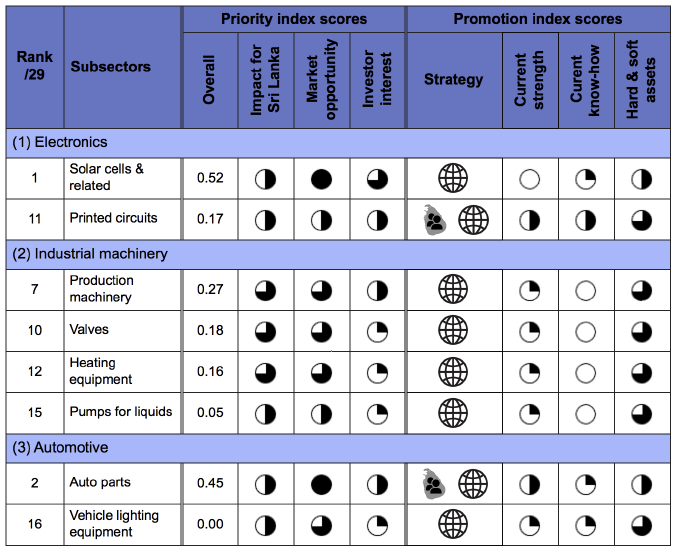
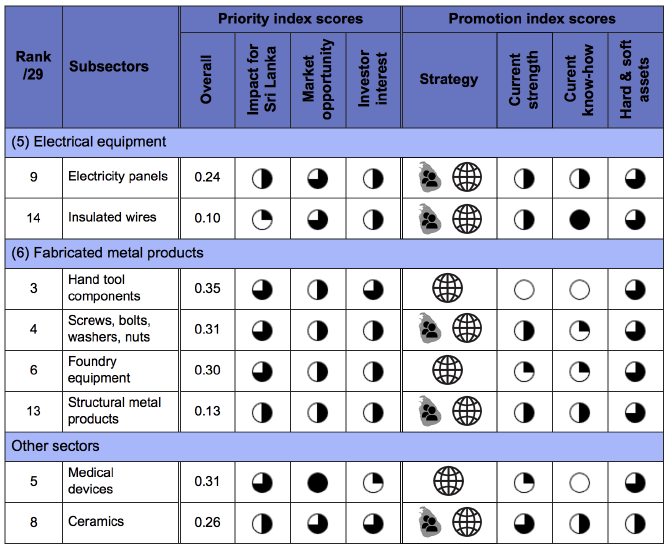

Figure 5: Index scores of top priority subsectors (source: Targeting Sectors for Investment and Export Promotion in Sri Lanka).
Problem Driven Iterative Adaptation (PDIA)
CID used the PDIA technique to facilitate the government to take ownership of research studies by ensuring that government officials lead their research. This sense of ownership was to ensure that the research is navigated to serve a specific research question of the government while building government capacity on trade-related research.
The PDIA process
In Sri Lanka, the Prime Minister had asked the BOI, EDB and the Sri Lanka Tourism Development Authority to focus their efforts on increasing investment and exports. The team worked with experts from Harvard Center for International Development (CID) through a Problem Driven Iterative Adaptation (PDIA) program (Andrews, Pritchett and Woolcock, 2013) lasting for six months, from August 2016 to January 2017. The PDIA process consists of few steps, starting with identifying problems that team members wish to solve, and deciding what are the initial actions to be taken to solve it. For this purpose, those agencies convened seven teams of officers (including the Targeting Team). Each team was given a task – such as developing a targeting mechanism – but was allowed to choose its own solutions. At weekly meetings, each team discussed their progress towards solving the problem, and what additional steps were needed in the next weeks. These teams were meant to be temporary, bound to specific problems: after six-month increments, each team decided whether to continue their work, or to switch to a different task, or to dissolve.
(source: “Targeting Sectors for Investment and Export Promotion in Sri Lanka”)
A 2017 report detailing the complete PDIA methodology and results is published here.
Read Part 2: Re-visiting the “Sector Targeting” study: Assessing the study’s impact
